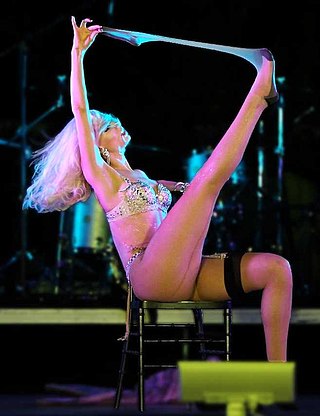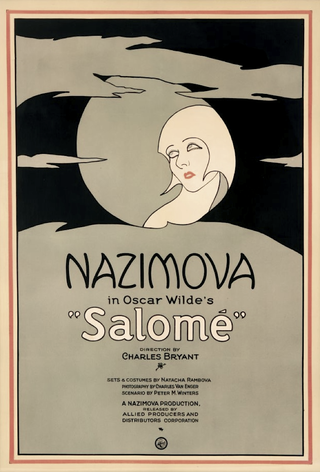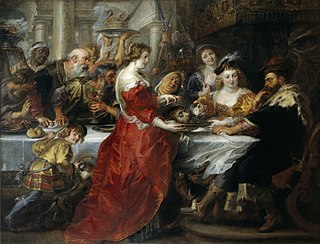
A striptease is an erotic or exotic dance in which the performer gradually undresses, either partly or completely, in a seductive and sexually suggestive manner. The person who performs a striptease is commonly known as a "stripper" or an "exotic" or "burlesque" dancer.

Salomé is a 1922-23 silent film directed by Charles Bryant and Alla Nazimova, who also stars. It is an adaptation of the 1891 Oscar Wilde play of the same name. The play itself is a loose retelling of the biblical story of King Herod and his execution of John the Baptist at the request of Herod's stepdaughter, Salomé, whom he lusts after.

Salome, also known as Salome III, was a Jewish princess, the daughter of Herod II and princess Herodias. She was granddaughter of Herod the Great, and stepdaughter of Herod Antipas. She is known from the New Testament, where she is not named, and from an account by Flavius Josephus. In the New Testament, the stepdaughter of Herod Antipas demands and receives the head of John the Baptist. According to Josephus, she was first married to her uncle Philip the Tetrarch, after whose death she married her cousin Aristobulus of Chalcis, thus becoming queen of Armenia Minor.

Herodias was a princess of the Herodian dynasty of Judaea during the time of the Roman Empire. Christian writings connect her with the execution of John the Baptist.

Herod Antipas was a 1st-century ruler of Galilee and Perea. He bore the title of tetrarch and is referred to as both "Herod the Tetrarch" and "King Herod" in the New Testament, although he never actually held the title of king. He was a son of Herod the Great and a grandson of Antipater the Idumaean. He is widely known today for accounts in the New Testament of his role in events that led to the executions of John the Baptist and Jesus of Nazareth. His father, Herod the Great, was alleged to have ordered the Massacre of the Innocents, marking the earliest Biblical account of the concerns of the government in Jerusalem regarding Jesus's existence.

Salome, Op. 54, is an opera in one act by Richard Strauss. The libretto is Hedwig Lachmann's German translation of the 1891 French play Salomé by Oscar Wilde, edited by the composer. Strauss dedicated the opera to his friend Sir Edgar Speyer.

Salome is a one-act tragedy by Oscar Wilde. The original version of the play was first published in French in 1893; an English translation was published a year later. The play depicts the attempted seduction of Jokanaan by Salome, stepdaughter of Herod Antipas; her dance of the seven veils; the execution of Jokanaan at Salome's instigation; and her death on Herod's orders.

Salome's Last Dance is a 1988 British film written and directed by Ken Russell. Although most of the action is a verbatim performance of Oscar Wilde's 1891 play Salome, which is itself based on a story from the New Testament, there is also a framing narrative that was written by Russell.

Salome is a 1953 American drama Biblical film directed by William Dieterle and produced by Buddy Adler from a screenplay by Harry Kleiner and Jesse Lasky Jr. The music score was by George Duning, the dance music by Daniele Amfitheatrof and the cinematography by Charles Lang. Rita Hayworth's costumes were designed by Jean Louis. Hayworth's dances for this film were choreographed by Valerie Bettis. This film was the last produced by Hayworth's production company, the Beckworth Corporation.
Herod II was the son of Herod the Great and Mariamne II, the daughter of Simon Boethus the High Priest, and the first husband of Herodias, daughter of Aristobulus IV and his wife Berenice. For a brief period he was his father's heir apparent, but Herod I removed him from succession in his will. Some writers call him Herod Philip I, as the Gospel of Matthew and Gospel of Mark state that Herodias was married to a "Philip". Because he was the grandson of Simon Boethus, he is sometimes also called Herod Boethus, but there is no evidence he was actually thus called during his lifetime. (Josephus states this Mariamne II, daughter of simon boethus, had a son named Herod who was removed from his will on his death bed and also divorced this mariamne for plots against Agrippa, this family of simon boethus is the same boethus jesus speaks of, Magdalene, Martha, Lazarus and simon. Magdalene is the mariamne II, mother of Herod II!) Acts 12:11 " peter knocked on the door of the gate of the house of mary, mother of john" also points out she is high class gated community. Herodias married this Herod II, salome married Philip. It all can be proven in Josephus Antiquities chapter V:4. Editor added "philip" but it states clearly herod the great's son with mariamne, daughter of olympias and joseph ben joseph who was brother to herod the king!

Salomé is a 2002 Spanish film directed by Carlos Saura. The film is told from the perspective of a flamenco dance company that will mount a show devoted to the mythical and biblical figure of Salomé, as a story of love and vengeance. The movie is both about the performance and the preparation for it.

Salomè is a 1986 Italian-French drama film directed by Claude d'Anna and starring Jo Champa. It is an adaptation of the 1891 Oscar Wilde play play of the same name, and was entered into the 1986 Cannes Film Festival.

The Herodian kingdom was a client state of the Roman Republic ruled from 37 to 4 BC by Herod the Great, who was appointed "King of the Jews" by the Roman Senate. When Herod died, the kingdom was divided among his sons into the Herodian Tetrarchy.

The Feast of Herod refers to the episode in the Gospels following the Beheading of St. John the Baptist, when Salome presents his head to her parents. The account in the Book of Mark describes Herod Antipas holding a banquet on his birthday for his high officials and military commanders, and leading men of Galilee. At this banquet, Herod's daughter dances before Herod, who is pleased and offers her anything she asks for in return. The girl asks her mother what she should request, and she is told to demand the head of John the Baptist. Reluctantly, Herod orders the beheading of John, and John's head is delivered to her, at her request, "on a platter."(Mark 6:17–29)

The Apparition(French: L'Apparition) is a painting by French artist Gustave Moreau, painted between 1874 and 1876. It shows the biblical character of Salome dancing in front of Herod Antipas with a vision of John the Baptist's severed head. The 106 cm high and 72,2 cm wide watercolor held by the Musée d'Orsay in Paris elaborates on an episode told in the Matthew 14:6–11 and Mark 6:21–29. On a feast held for Herod Antipas' birthday, the princess Salome dances in front of the king and his guests. This pleased him so much he promises her anything she wished for. Incited by her mother Herodias, who was reproved by the John the Baptist for her illegitimate marriage to Herod, Salome demands John's head on a charger. Regretful but compelled to keep his word in front of everyone present, Herod complies with Salome's demand. John the Baptist is beheaded, his head brought on a charger and given to Salome, who in turn gives it to her mother.

The Peacock Skirt is an 1893 illustration by Aubrey Beardsley. His original pen and ink drawing was first reproduced as a wood engraving in the first English edition of Oscar Wilde's one-act play Salome in 1894. In later editions it was photo-mechanically reproduced as a lineblock for printing. The original drawing was bequeathed by Grenville Lindall Winthrop to the Fogg Art Museum at Harvard University in 1943.

Salome Dancing before Herod is an oil painting produced in 1876 by the French Symbolist artist Gustave Moreau. The subject matter is taken from the New Testament, depicting Salome—the daughter of Herod II and Herodias—dancing before Herod Antipas.
"Salome" is a 1968 Australian TV play starring Frank Thring. It was based on the 1891 play of the same name by Oscar Wilde and was reportedly the first time that play had been adapted for television.

Salome by Oscar Wilde, a play written in 1891 and first produced in 1896, has been analysed by numerous literary critics, and has prompted numerous derivatives. The play depicts the events leading to the execution of Iokanaan at the instigation of Salome, step-daughter of Herod Antipas, and her death on Herod's orders.

Salome, also known as Salome with the Head of John the Baptist, is an oil painting by the Venetian painter Titian, made in about 1550, and currently in the collection of the Museo del Prado in Madrid. It is not to be confused with other compositions of Salome and Judith by Titian.





















